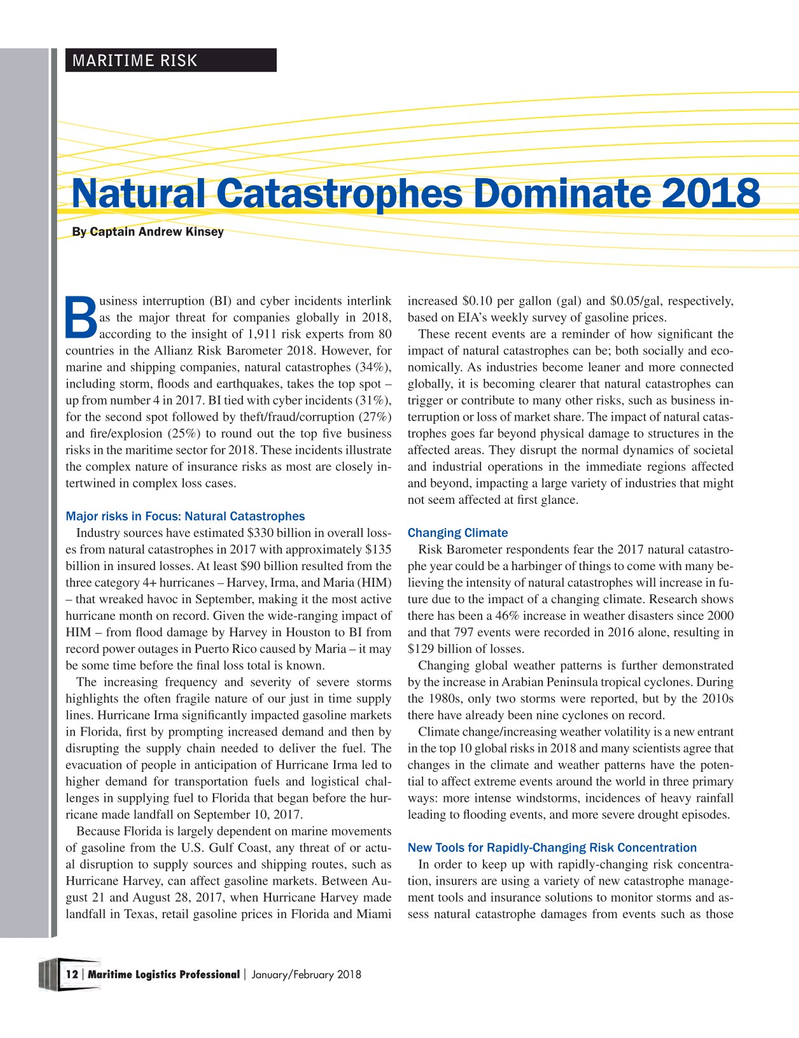
Page 12: of Maritime Logistics Professional Magazine (Jan/Feb 2018)
Cruise Shipping Trends
Read this page in Pdf, Flash or Html5 edition of Jan/Feb 2018 Maritime Logistics Professional Magazine
MARITIME RISK
Natural Catastrophes Dominate 2018
By Captain Andrew Kinsey usiness interruption (BI) and cyber incidents interlink increased $0.10 per gallon (gal) and $0.05/gal, respectively, as the major threat for companies globally in 2018, based on EIA’s weekly survey of gasoline prices.
Baccording to the insight of 1,911 risk experts from 80 These recent events are a reminder of how signi? cant the countries in the Allianz Risk Barometer 2018. However, for impact of natural catastrophes can be; both socially and eco- marine and shipping companies, natural catastrophes (34%), nomically. As industries become leaner and more connected including storm, ? oods and earthquakes, takes the top spot – globally, it is becoming clearer that natural catastrophes can up from number 4 in 2017. BI tied with cyber incidents (31%), trigger or contribute to many other risks, such as business in- for the second spot followed by theft/fraud/corruption (27%) terruption or loss of market share. The impact of natural catas- and ? re/explosion (25%) to round out the top ? ve business trophes goes far beyond physical damage to structures in the risks in the maritime sector for 2018. These incidents illustrate affected areas. They disrupt the normal dynamics of societal the complex nature of insurance risks as most are closely in- and industrial operations in the immediate regions affected tertwined in complex loss cases. and beyond, impacting a large variety of industries that might not seem affected at ? rst glance.
Major risks in Focus: Natural Catastrophes
Industry sources have estimated $330 billion in overall loss- Changing Climate es from natural catastrophes in 2017 with approximately $135 Risk Barometer respondents fear the 2017 natural catastro- billion in insured losses. At least $90 billion resulted from the phe year could be a harbinger of things to come with many be- three category 4+ hurricanes – Harvey, Irma, and Maria (HIM) lieving the intensity of natural catastrophes will increase in fu- – that wreaked havoc in September, making it the most active ture due to the impact of a changing climate. Research shows hurricane month on record. Given the wide-ranging impact of there has been a 46% increase in weather disasters since 2000
HIM – from ? ood damage by Harvey in Houston to BI from and that 797 events were recorded in 2016 alone, resulting in record power outages in Puerto Rico caused by Maria – it may $129 billion of losses. be some time before the ? nal loss total is known. Changing global weather patterns is further demonstrated
The increasing frequency and severity of severe storms by the increase in Arabian Peninsula tropical cyclones. During highlights the often fragile nature of our just in time supply the 1980s, only two storms were reported, but by the 2010s lines. Hurricane Irma signi? cantly impacted gasoline markets there have already been nine cyclones on record. in Florida, ? rst by prompting increased demand and then by Climate change/increasing weather volatility is a new entrant disrupting the supply chain needed to deliver the fuel. The in the top 10 global risks in 2018 and many scientists agree that evacuation of people in anticipation of Hurricane Irma led to changes in the climate and weather patterns have the poten- higher demand for transportation fuels and logistical chal- tial to affect extreme events around the world in three primary lenges in supplying fuel to Florida that began before the hur- ways: more intense windstorms, incidences of heavy rainfall ricane made landfall on September 10, 2017. leading to ? ooding events, and more severe drought episodes.
Because Florida is largely dependent on marine movements of gasoline from the U.S. Gulf Coast, any threat of or actu- New Tools for Rapidly-Changing Risk Concentration al disruption to supply sources and shipping routes, such as In order to keep up with rapidly-changing risk concentra-
Hurricane Harvey, can affect gasoline markets. Between Au- tion, insurers are using a variety of new catastrophe manage- gust 21 and August 28, 2017, when Hurricane Harvey made ment tools and insurance solutions to monitor storms and as- landfall in Texas, retail gasoline prices in Florida and Miami sess natural catastrophe damages from events such as those 12 Maritime Logistics Professional January/February 2018 | | 1-17 MLP JanFeb18.indd 12 1-17 MLP JanFeb18.indd 12 2/14/2018 3:41:57 PM2/14/2018 3:41:57 PM

 11
11

 13
13
